
Puget Sound Mosquito Fleet
Encyclopedia
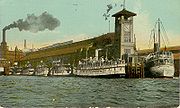
Puget Sound
Puget Sound is a sound in the U.S. state of Washington. It is a complex estuarine system of interconnected marine waterways and basins, with one major and one minor connection to the Strait of Juan de Fuca and the Pacific Ocean — Admiralty Inlet being the major connection and...
and nearby waterways and rivers. This large group of steamers
Steamboat
A steamboat or steamship, sometimes called a steamer, is a ship in which the primary method of propulsion is steam power, typically driving propellers or paddlewheels...
and sternwheelers plied the waters of Puget Sound
Puget Sound
Puget Sound is a sound in the U.S. state of Washington. It is a complex estuarine system of interconnected marine waterways and basins, with one major and one minor connection to the Strait of Juan de Fuca and the Pacific Ocean — Admiralty Inlet being the major connection and...
, stopping at every waterfront dock
Dock (maritime)
A dock is a human-made structure or group of structures involved in the handling of boats or ships, usually on or close to a shore.However, the exact meaning varies among different variants of the English language...
. The historical period defining the beginning and end of the Mosquito Fleet is ambiguous, however the peak of activity occurred between the first and second World Wars.
Beginnings
Puget Sound and the many adjacent waterways, inlets, and bays form a natural transportation route for much of the western part of the State of Washington. For navigation purposes, Puget Sound was sometimes divided into the "upper Sound" referring to the waters south of the Tacoma NarrowsTacoma Narrows
The Tacoma Narrows , a strait, is part of Puget Sound in the U.S. state of Washington. A navigable maritime waterway between glacial landforms, the Narrows separates the Kitsap Peninsula from the city of Tacoma....
, and the lower sound, referring to the waters from the Tacoma Narrows north to Admiralty Inlet.
The first steamboat to operate on Puget Sound was the Beaver
Beaver (steamship)
Beaver was the first steamship to operate in the Pacific Northwest of North America. She made remote parts of the west coast of Canada accessible for maritime fur trading and was chartered by the Royal Navy for surveying the coastline of British Columbia....
, starting in the late 1830s. Beaver was a sidewheeler built in London, which reached the Northwest under sail, with her paddle wheels dismantled. In 1853, Hudson’s Bay Company brought a new steam-powered vessel into the area, the Otter, a propeller-driven bark,
The Native Americans
Indigenous peoples of the Americas
The indigenous peoples of the Americas are the pre-Columbian inhabitants of North and South America, their descendants and other ethnic groups who are identified with those peoples. Indigenous peoples are known in Canada as Aboriginal peoples, and in the United States as Native Americans...
traversed Puget Sound in well-built cedar canoes, as they had for thousands of years, and for some time so did the American settlers, who only began to arrive in very small numbers in 1846. In 1851, Olympia became the only formal American town on Puget Sound. In November 1851, the schooner Exact disembarked passengers at Alki Point, which was the beginning of the city of Seattle. In February 1852, three of the settlers, Arthur A. Denny, C.D. Boren, and William N. Bell took soundings on the east side of Elliot Bay, found the water to be deep enough near the shore to form a port, and staked land claims along the water.
The first American steamboat on Puget Sound was the sidewheeler Fairy
Fairy (steamboat)
Fairy was a small wooden sidewheel-driven steamship placed into service on Puget Sound in 1853. Fairy was the first steam-powered vessel to conduct regularly scheduled service on Puget Sound.-Career:...
built in San Francisco in 1852. Captain Warren Gove, born in Edgecomb ME in 1816 (one of three Gove brothers involved in early maritime affairs) brought Fairy to Puget Sound on the deck of the bark Sarah Warren and lowered her into the sound on October 31, 1853. Fairy was the first steamboat on Puget Sound to have a formal schedule, published for the first time on November 12, 1853 in the Columbian newspaper of Olympia. The "splendid steamer" Fairy, as she was advertised, was supposed to make two trips a week between Olympia and Steilacoom, and one trip a week from Olympia to Seattle. Fares were high, $5 for Olympia-Steilacoom, and $10 for Olympia-Seattle. Fairy however proved unseaworthy in the rougher winter weather in the lower sound, and after a few runs from Olympia to the then very small village of Seattle was eventually replaced by a sailing schooner
Schooner
A schooner is a type of sailing vessel characterized by the use of fore-and-aft sails on two or more masts with the forward mast being no taller than the rear masts....
, which ran irregularly and, more predictably, by mail and passenger canoes. These were owned and crewed by the First Nations. It took in those days at least two days and often three to make the trip from Seattle to Olympia, and travellers camped on the beach at night. (Following her failure on the upper sound, Fairy was placed on the much shorter Olympia-Fort Steilacoom run, until 1857 when her boiler exploded. No one was killed, but that was the end of her.)
The next steamboat on the Sound was the Major Tompkins, which arrived on September 16, 1854. Tompkins (151 tons and 97' long) was an iron-hulled steam propeller built at Philadelphia in 1847, and somehow brought around South America to California, where she had collected gold from gold seekers during the great California gold rush. Paid off by her California competitors in a typical monopolistic deal of the era, Major Tomkins was sitting idle at the dock in San Francisco in 1854 when she was bought by Capt. James M. Hunt and John M. Scranton who brought her up north to Puget Sound. Once she arrived, the Pumpkins, as the locals called her, made her very slow way (approximately 5 miles per hour) among Olympia, Seattle, Victoria and other places, carrying mail, freight, and passengers. Pumpkins was lost at Victoria, blown ashore in a squall following a mistake in navigation, fortunately all aboard reached safety in a narrow escape.
Effect of Fraser River Gold Rush
Other boats were brought in during these early times, including among others, Traveler, Constitution, the diminutive Water Lily, Daniel Webster, Sea Bird, and the steeple-engined Wilson G. Hunt, none of them succeeding particularly well until the Fraser River Gold Rush in 1858. Puget Sound then became a shipping point for supplies and goldseekers, and the steamboats profited well. Bellingham BayBellingham Bay
Bellingham Bay is a bay located on the northern Pacific coast of Washington state in the United States. It is separated from the Strait of Georgia on the west by the Lummi Peninsula, Portage Island, and Lummi Island. It is bordered on the east by Bellingham, Washington, to the south-east by the...
was one jumping off point for the rush, which was handicapped by the almost complete lack of roads or paths into the mainland of British Columbia
British Columbia
British Columbia is the westernmost of Canada's provinces and is known for its natural beauty, as reflected in its Latin motto, Splendor sine occasu . Its name was chosen by Queen Victoria in 1858...
at the time, and boats were also brought in to carry miners from Victoria to the mainland, and thereafter up the Fraser River.
Rise of steam navigation
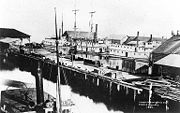
Eliza Anderson (sidewheeler)
The PS Eliza Anderson operated from 1858 to 1898 mainly on Puget Sound, the Strait of Georgia, and the Fraser River but also for short periods in Alaska. She was generally known as the Old Anderson and was considered slow and underpowered even for the time...
. Her owners equipped Eliza Anderson with a steam calliope
Calliope
In Greek mythology, Calliope was the muse of epic poetry, daughter of Zeus and Mnemosyne, and is now best known as Homer's muse, the inspiration for the Odyssey and the Iliad....
which blasted out a variety of tunes, including (to the irritation of Canadians when she operated north of the border) ”Yankee Doodle”
Yankee Doodle
"Yankee Doodle" is a well-known Anglo-American song, the origin of which dates back to the Seven Years' War. It is often sung patriotically in the United States today and is the state anthem of Connecticut...
and ”The Star Spangled Banner” Other boats began to appear, and by 1864, J.B. Libby, Mary Woodruff, Pioneer, Alexandra and Jenny Jones had all appeared on the sound. Steamboat operations were still irregular and unsatisfactory to the general public, as shown by a newspaper commentary of the day:
In April 1866, the sidewheeler Cyrus Walker
Cyrus Walker (sidewheel tug)
Cyrus Walker was a sidewheel tug active in Puget Sound in the second half of the 19th century.-References:* Affleck, Edwin L, ed. A Century of Paddlewheelers in the Pacific Northwest, the Yukon, and Alaska, Alexander Nicholls Press, Vancouver, BC ISBN 0-920034-08-X...
arrived in the Sound under Capt. A.B. Gove. Seattle residents, predominantly male and apparently hard-drinking, mistook her for the promised ship full of brides that Asa Mercer was supposed to be bringing from the east coast. Supposedly a tug, Cyrus Walker also carried freight and passengers; in those days on the sound, no firm distinction was necessarily drawn between steam tugs and other steam-driven craft. Eliza Anderson was still dominating the main route on the sound at the time, which was the Olympia to Victoria run. Slow but cheap to operate, the Eliza bested all competitors, including Josie McNear, New World, and the oddly-designed (as a result of her steeple engine) Wilson G. Hunt
Wilson G. Hunt (sidewheeler)
Wilson G. Hunt was a steamboat that ran in the early days of steam navigation on Puget Sound and Sacramento, Fraser, and Columbia Rivers. She was generally known as the Hunt during her years of operation. She had a long career on the west coast of the United States and Canada, and played an...
Boom time

George E. Starr (steamboat)
The steamboat George E. Starr operated in late 19th century as part of the Puget Sound Mosquito Fleet and also operated out of Victoria, B.C. Geo. E. Starr also served for a time in California and on the Columbia River.-Construction:Geo. E...
named in his honor.
By the 1880s and 1890s the population the Puget Sound region had risen greatly, and steamboat technology had also improved. Many new and fast vessels were launched, such as the sternwheelers Greyhound
Greyhound (sternwheeler 1890)
The Greyhound was an express passenger steamer which operated in 1890s to about 1915 on Puget Sound in Washington, United States. This vessel, commonly known as the Hound, the Pup or the Dog, was of unusual design, having small upper works, but an enormous sternwheel...
and Bailey Gatzert
Bailey Gatzert (sternwheeler)
The Bailey Gatzert was a famous sternwheel steamboat that ran on the Columbia River and Puget Sound from the 1890s to the 1920s. She was named after Bailey Gatzert, an early businessman and mayor of Seattle...
and the famous propeller steamer Flyer
Flyer (steamboat 1891)
Flyer was a steamboat that served from 1891 to 1929 on Puget Sound. During her last years, from 1918 to the end of her service, she was officially known as the Washington. The Flyer ran for millions of miles at high speed, more than any inland vessel in the world...
. Roads were still poor, and of course there were as yet no automobiles. The water route was the preferred way to travel between the cities on the Sound. In 1890, for example, regular daily service began between Tacoma and Seattle with the Greyhound. In the early 1900s, larger and more durable steel hulled boats were either built at Puget Sound shipyards, like the Tacoma (launched 1913) or brought in from other areas, like Indianapolis, Iroquois, and Chippewa. The Tacoma could make the run from Seattle to Tacoma in 77 minutes dock to dock.
Navigation
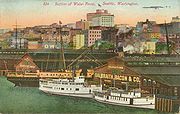
Athlon (steamboat)
-Construction:Athlon was built in Portland, Oregon by the J.H. Johnston yard. Her first owners were a consortium of Jacob Kamm , Shaver Transportation Company and the Kellogg Transportation Company. The consortium built her at a cost of $4,950...
. Others like the East Pass route of the Virginia V
Virginia V
The steamship Virginia V is the last operational example of a Puget Sound Mosquito Fleet steamer...
warranted a mixed-use passenger/freight/mail boat.
One important consideration which will not necessarily be obvious in modern times of radar, GPS and depth-sounders, is the degree to which navigational skill and experience on a particular route played in making sure each run was completed safely and profitably. The steamboats could not run only in fair weather or in the daytime. Heavy fog was particularly hazardous, and could come any time of year. Once a steamboat was in a fog bank, a captain would have to reckon very carefully from his experience on the run just where his boat was. While there was no radar, captains proved remarkably adept at determining their position with echoes from the steamboat's whistle. Sound travels at about 1080 feet per second in a fog bank, and rounding off to a 1000 feet for safety, that meant that if an echo was heard one second after the whistle blast, the steamboat was 500 feet from shore. The maritime historian Jim Faber well-summarized the degree of detail that an experienced crew could deduce by echo location:
It took an experienced captain years of navigation on a particular route to be able to safety pilot his boat through a fog bank or a dark rainy night using this method. This of course made it difficult simply to put a new boat on a particular route without a crew with strong local experience.
Selected Routes and landings
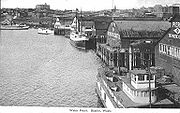
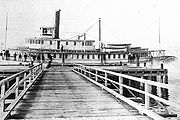

Olympia
Olympia's main steamboat landing was Percival Dock. In 1910, boats operating from this dock included the then-new gasoline-engined tug Sandman, the Foss launch Lark, and the mail boat Mizpah. The sternwheeler MultnomahMultnomah (sternwheeler)
The sternwheeler Multnomah was built at East Portland, Oregon in 1885 and operated on the Willamette and Columbia Rivers until 1889 in the United States...
also came to Percival Dock on her Seattle-Tacoma-Olympia route.
Shelton
The little sternwheeler Willie (67 feet long) was built at Seattle in 1883 for the Samish river service. In 1886 Capt. Ed Gustafson bought her and put her on the Olympia-Shelton route. In 1895, Captain Gustafson replaced her with the City of Shelton, and Willie went north of the border to serve on the Fraser RiverFraser River
The Fraser River is the longest river within British Columbia, Canada, rising at Fraser Pass near Mount Robson in the Rocky Mountains and flowing for , into the Strait of Georgia at the city of Vancouver. It is the tenth longest river in Canada...
.
Hood Canal
In 1899, service to Hood CanalHood Canal
Hood Canal is a fjord forming the western lobe, and one of the four main basins, of Puget Sound in the state of Washington. Hood Canal is not a canal in the sense of being a man-made waterway—it is a natural waterway.-Geography:...
from Seattle's Pier 3 (now Pier 54) was effected by the propeller steamer Dode
Dode (steamboat)
Dode was a steamboat that ran on Hood Canal and Puget Sound from 1898 to 1900.- Construction:Dode was originally the schooner William J. Bryant. Prior to construction as the Dode, the Bryant had been one of a flotilla of Gold Rush ships sent to Alaska...
. A typical wooden boat of the Mosquito Fleet, the 99' long Dode left Seattle every Tuesday on the run to Kingston
Kingston, Washington
-External links:* *...
, Port Gamble
Port Gamble, Washington
Port Gamble is an unincorporated community on the northwestern shore of the Kitsap Peninsula in Kitsap County, Washington, United States. It is also a small, similarly named bay, along which the community lies, near the entrance to Hood Canal. The unincorporated communities of Port Gamble and...
, Seabeck
Seabeck, Washington
Seabeck is a former mill town in Kitsap County, Washington, United States, on Hood Canal.- History :The name Seabeck comes from the Twana /ɬqábaqʷ/, from /ɬ-/, "far", /qab/, "smooth, calm", and /-aqʷ/, "water"....
, Brinnon
Brinnon, Washington
-Demographics:As of the census of 2000, there were 803 people, 413 households, and 258 families residing in the CDP. The population density was 81.3 people per square mile . There were 912 housing units at an average density of 92.4/sq mi...
, Holly
Holly, Washington
Holly is an unincorporated community in Kitsap County, Washington, United States. Named in 1895 for the presence of a large holly tree, Holly is located in the southwestern corner of the county, along the Hood Canal....
, Dewatto, Lilliwaup Falls
Lilliwaup, Washington
Lilliwaup is a small unincorporated community in Mason County, Washington, United States. It is located on the west shore of Hood Canal at the mouth of Lilliwaup Creek. US Highway 101 passes through the town.-History:...
, Hoodsport
Hoodsport, Washington
Hoodsport is an unincorporated community in Mason County, Washington, United States. Hoodsport is located along the Hood Canal, at the intersection of U.S. Route 101 and State Route 119. Lake Cushman is nearby. Hoodsport is the gateway to the Staircase area of Olympic National Park.The first...
, and, at the end of what must have been a long day, Union City. The next morning she'd return to Seattle on the same route.
Crew safety
Safety was a constant issue for steamboats. Some vessels, particularly the later steel-hulled ones, had perfect safety records. This was not always true, and the lives of both passengers and crew were often endangered. There are many instances of crewmen falling off vessels and drowning. Crew did not wear life preservers, as is now required on all riverine vessels. For example, in the case of the MizpahMizpah (steamboat)
The steamboat Mizpah operated in the early 1900s as part of the Puget Sound Mosquito Fleet.-Construction:Construction of Mizpah began in 1901 at Olympia, but the vessel was not launched until 1905, when she was completed by Capt. John C. Ross. Mizpah was propeller-driven, 55' long, and rated at...
, the engineer went on deck, apparently slipped, fell overboard and was drowned. Another unfortunate case was that of Captain O.A. Anderson, a Port Townsend pilot who fell from a ladder in rough seas in late December, 1912, when trying to board the steamship Setos from the pilot launch.
Fire

General Slocum
The PS General Slocum was a passenger steamboat built at Brooklyn, New York, in 1891. The General Slocum was named for Civil War officer and New York Congressman Henry Warner Slocum. She operated in the New York City area as an excursion steamer for the next thirteen years under the same ownership...
on June 15, 1904, in which more than 1,000 people died. While the General Slocum was a large vessel, there were a number of similar sized wooden boats on Puget Sound and the Columbia River (for example, Alaskan
Alaskan (sidewheeler)
The steamship Alaskan operated from 1884 to 1889 on the Columbia River and Puget Sound. Alaskan and her near-sistership Olympian were known as “Henry Villard’s White Elephants.” There were a number of vessels named Alaska and Alaskan, this large side-wheel steamboat should not be confused with...
, Olympian
Olympian (sidewheeler)
The steamship Olympian operated from 1884 to about 1890 on the Columbia River, Puget Sound, and the Inside Passage of British Columbia and Alaska...
and, in particular Yosemite
Yosemite (sidewheeler)
The steamboat Yosemite operated for almost fifty years on San Francisco Bay, the Sacramento River, inland coastal waters and the lower Fraser River in British Columbia, and Puget Sound.-Design:...
, which routinely boarded more than 1,000 passengers) where on a busy day or a crowded excursion such a death toll could have occurred. Hunter, one of the premier historians of steamboats on the Mississippi-Ohio-Missouri river systems, well summarized the causes of fire in wooden steam craft:
The cause of fire can be readily seen when one considers that in the midst of this pile of oil-soaked wood, there was placed the biggest furnace that could be afforded by the owner, capped with an enormous smokestack to generate the maximum amount of draft for the fire. Added to this was the risk, in the days before electric light, associated with oil and kerosene lanterns and other sources of ignition. Many vessels were destroyed by fire, two examples being Mizpah
Mizpah (steamboat)
The steamboat Mizpah operated in the early 1900s as part of the Puget Sound Mosquito Fleet.-Construction:Construction of Mizpah began in 1901 at Olympia, but the vessel was not launched until 1905, when she was completed by Capt. John C. Ross. Mizpah was propeller-driven, 55' long, and rated at...
and Urania
Urania (steamboat)
The steamboat Urania was a vessel that operated on Lake Washington in the first part of the 20th Century. Built of wood, the vessel burned and sank in 1914...
.
Collision
Collisions were also too common, when steamboats continued to operate in fog or night, without radar or other modern navigation aids, and often caused greater loss of life than fire. Unlike fire, which often could be fought until the vessel reached a beach where passengers and crew could evacuate, collisions came suddenly. Where there was a substantial difference between the size or construction of the vessels, such as steel against wooden hull, destruction could be quick. Thus, on the night of November 18, 1906, the small lightly built passenger steamer DixDix (steamboat)
The steamboat Dix operated from 1904 to 1906 as part of the Puget Sound Mosquito Fleet. She was sunk in a collision which remains one of the most serious transportation accidents in the state of Washington to this day....
(130 tons), designed specifically for the very short run across Elliot Bay from Seattle to Alki Point collided with the much larger steam schooner Jeanie. The night was clear, and the collision seems to have been caused by an error of the Dixs unlicensed mate, who had the wheel while the captain, consistent with the practice of the day, collected the fares. Even though the collision speed was small, Dix was lightly built and top-heavy; she quickly heeled over, filled with water and sank in 103 fathoms, taking 45 people down with her, including her mate. The wreck was so deep that no bodies could be recovered. Similarly, but less tragically, the wooden sternwheeler Multnomah
Multnomah (sternwheeler)
The sternwheeler Multnomah was built at East Portland, Oregon in 1885 and operated on the Willamette and Columbia Rivers until 1889 in the United States...
was rammed (also in Elliot Bay, scene of much marine traffic) by the much larger steel-hulled express passenger Iroquois on October 28, 1911, sinking Multnomah in 240 feet of water, fortunately with no one reported killed.
Loss of the Clallam
By 1904, the causes of shipping losses were well-known and safety measures had been established by law, and enforced by the U.S. Steamboat inspection serviceSteamboat Inspection Service
The Steamboat Inspection Service was a United States agency created in 1852 to safeguard lives and property at sea. It merged with the Bureau of Navigation in 1932 to form the Bureau of Navigation and Steamboat Inspection which, in 1936, was reorganized into the Bureau of Marine Inspection and...
. Each vessel's certificate stated how many lifeboats, fire axes, and similar items were supposed to be carried. Yet that year saw the tragic loss of life on the Clallam
Clallam (steamboat)
The steamboat Clallam operated for about six months from July 1903 to January 1904 in Puget Sound and the Strait of Juan de Fuca. She was sunk in a storm on what should have been an ordinary voyage to Victoria, British Columbia.-Construction:...
, which left Seattle bound for Victoria on January 8, 1904, under the command of Capt. George Roberts. A storm came up as she neared Victoria, and she started taking on water. When her pumps failed (apparently they actually brought water into the vessel rather than evacuating it), her boiler fire was extinguished by the rising water, and she lost all power, save for an emergency sail. The captain ordered three lifeboats launched, and put into them the women and children, yet no ship’s officers went on board to command the boats in the rough seas. All three boats were lost with all the passengers on them. Clallam stayed afloat long enough to be found by rescuers, but even so, 54 lives were lost. Serious shiphandling and mechanical defects seemed to have caused the loss of the Clallam, and the license of her master, George Roberts, a 29-year veteran steamboat man, was suspended and that of her chief engineer was revoked. There also seem to have been an insufficient supply of signaling rockets.
Crackdown by steamboat inspectors
Following the Clallam disaster, there was a crack-down on violations of the steamboat safety regulations, which seem to have been widely ignored. At Port Townsend, following a surprise inspection of the steamer Garland on February 6, 1904, the following defects were found:- no relieving tackleRelieving tackleRelieving tackle is one or more lines attached to a vessel's steering mechanism, to assist or substitute for the whipstaff or ship's wheel in steering the craft...
on the tiller (this was necessary to steer the vessel in case of wheel failure or loss of the main steering ropes through fire); - no ladders or stairways to the hurricane deck where the fire buckets and lifeboats were kept;
- fewer fire buckets than required by the vessel’s certificate, and no water in many of what firebuckets were on board;
- fewer fire axes than required by her certificate;
- life raft had no designation on it of the number of persons it was supposed to carry in an emergency;
- lifeboats and launching gear generally in poor condition.
Similar conditions were found on the same day on the Prosper, and to a lesser degree on the Alice Gertude
Alice Gertrude
Alice Gertrude was a wooden steamship which operated on the Strait of Juan de Fuca and Puget Sound from 1898 to January 1907, when the vessel was wrecked at Clallam Bay.- Career:...
and the Whatcom, although they were referred for special boiler inspections. The inspections and fines assessed on these four vessels were just part of a campaign by the inspectors to enforce the regulations on all steam craft operating in Puget Sound. By February 17, 1904, sixteen more vessels, including some well-known ones, had been inspected, found deficient, and fined for similar reasons, and in addition failure to maintain adequate fog horns and not providing sufficient written instructions to passengers as to the location of life preservers. Vessels found deficient included among others the well-known George E. Starr
George E. Starr (steamboat)
The steamboat George E. Starr operated in late 19th century as part of the Puget Sound Mosquito Fleet and also operated out of Victoria, B.C. Geo. E. Starr also served for a time in California and on the Columbia River.-Construction:Geo. E...
, Rosalie
Rosalie (steamship)
The steamboat Rosalie operated from 1893 to 1918 as part of the Puget Sound Mosquito Fleet, also operating out of Victoria, B.C. In 1898, Rosalie went north with many other Puget Sound steamboats to join the Klondike Gold Rush.-Construction:...
, and Athlon
Athlon (steamboat)
-Construction:Athlon was built in Portland, Oregon by the J.H. Johnston yard. Her first owners were a consortium of Jacob Kamm , Shaver Transportation Company and the Kellogg Transportation Company. The consortium built her at a cost of $4,950...
.
All of the many defects found by the steamboat inspectors on Puget Sound were unfortunately typical of the lax standards of the day, which contributed to the horrible death toll in the loss by fire in New York of the General Slocum
General Slocum
The PS General Slocum was a passenger steamboat built at Brooklyn, New York, in 1891. The General Slocum was named for Civil War officer and New York Congressman Henry Warner Slocum. She operated in the New York City area as an excursion steamer for the next thirteen years under the same ownership...
on June 15, 1904. This loss, which occurred while the General Slocum was packed with an excursion, produced swift results on Puget Sound, as inspectors strictly counted the total numbers of persons boarded on each vessel, and gave notice that there would be no more remissions of fines for equipment defects. (It had been the custom that heavy fines imposed on steamboats would be remitted upon a showing of compliance by the vessel's owners.)
Conversion to ferries and decline
As automobile ownership rose and highways and roads improved, passenger travel fell off. Many boats were converted to automobile ferries, the first being the Bailey Gatzert. Others were eventually just abandoned on beaches or never repaired after a wreck or a mechanical breakdown. Some, like the Magnolia, were converted into towboats. Others had different fates. Arcadia, the last passenger vessel (capacity 275 passengers, 100 tons freight) operating between Tacoma and upper Puget Sound landings under the command of Capt. Bernt Bertson, was sold to the federal government for use as a tender for the federal prison on McNeil Island, where she was renamed J.E. Overlade. This was not the end of Arcadia, however, as in 1959 she was bought back from the federal government by Puget Sound Excursion Lines, renamed Virginia VI, and placed in the excursion business with the Virginia V then under the same ownership.Nicknames and popular verse

The sidewheeler George E. Starr
George E. Starr (steamboat)
The steamboat George E. Starr operated in late 19th century as part of the Puget Sound Mosquito Fleet and also operated out of Victoria, B.C. Geo. E. Starr also served for a time in California and on the Columbia River.-Construction:Geo. E...
lasted from 1879 to 1911, and slowed down to the point where a song was composed about her:
It is said that William J. Fitzgerald, who later became Seattle's fire chief, at age 8 composed a little tribute to two Seattle pioneers and two famous steamboats as follows:
Final years
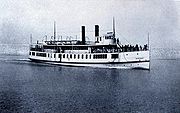
Moyie (sternwheeler)
The Moyie is a paddle steamer sternwheeler that worked on Kootenay Lake in British Columbia, Canada from 1898 until 1957.After her nearly sixty years of service, she was sold to the town of Kaslo and restored...
on Kootenay Lake in 1957. There were staged races up through the 1950s, and a few revivals on a few runs, even as late as the Second World War. But by the late 1920s, automobiles and highways had filled the transportation needs that steamboats had once supplied, and in 1930, the Tacoma made her last run on the Seattle-Tacoma route, under the command of Captain Everett D. Coffin, the only skipper she’d ever known . This marked the real end of commercial passenger activity for the steamboats. Newell and Williamson documented the occasion:
The Tacoma and the Indianapolis passed a little south of Three Tree Point. ... Capt. Coffin pulled down a window and leaned out in the driving rain. The Indianapolis floated by, a dozen squares of light topped by a star. She spoke; three long, lingering blasts. ... Capt. Coffin reached for his own whistle cord. Three long blasts. And he let the last blast die away slowly, until it was only a moan in the throat of the whistle. “That’s the last time we pass each other,” he said.
When Tacoma arrived at her dock in Tacoma harbor that last night, every ship in the port blew three blasts on their whistles as a salute. Andrew Foss, owner of the great Foss tug concern, sent Foss No. 17 help Tacoma make her landing, even though it had been two years since Tacoma could afford the help of a tug. As she left that last time on her return to Seattle, Tacoma passed the hull of the Greyhound, once the fastest boat on the Sound and now, minus her upper works, engines and sternwheel, in her last service as a mudscow.
Legacy
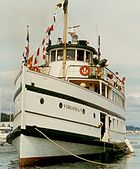
Washington State Ferries
Washington State Ferries is a passenger and automobile ferry service owned and operated by the Washington State Department of Transportation that serves communities on Puget Sound and in the San Juan Islands. It is the most used ferry system in the world and the largest passenger and automobile...
system now runs on many of the routes of the Mosquito Fleet, of which the fine steamer Virginia V, newly-restored, is one of the last remaining vessels. The oldest remaining vessel is the motor vessel "Carlisle II", built in Bellingham in 1917 and still in regular revenue service between Bremerton and Port Orchard for Kitsap Transit. Of the other little ships, Gordon Newell, one of their greatest historians, wrote:
As a modern reminder of the little ships, in 2001, Kitsap County inventoried all the many landings and docks of the Mosquito Fleet on Bainbridge Island and the Kitsap Peninsula
Kitsap Peninsula
The Kitsap Peninsula is an arm of land that is part of the larger Olympic Peninsula in Washington state that lies west of Seattle across Puget Sound. Hood Canal separates Kitsap Peninsula from the rest of the Olympic Peninsula...
, and developed the Kitsap County Mosquito Fleet Trail for bicycles and foot traffic. Presently, Kitsap Transit operates a passenger only ferry between Port Orchard and Bremerton. "The Carlyle II" has been designated as a floating museum. It is one of few mosquito fleet era ferries operating on Puget Sound today. It runs every half hour beginning on the hour and half hour on the Port Orchard side and 15 and 45 minutes after the hour on the Bremerton side. One-way fare is $2.00.
Return of the Mosquito Fleet
Occasionally there is talk of restoring the Mosquito Fleet, which in modern parlance has become known as the "passenger-only ferry," although it appears not much has come of these ideas, as they seem to be dependent on public funding or subsidies. (This would not have been unusual for the first Mosquito Fleet, as in the beginning, for example, mail contracts were sought as a means of support for the vessels.)Some movement towards this may be happening. In August 2007, the city of Kingston received a $3.5 million grant from the federal government to cover at least some of the costs of building a terminal and a passenger-only ferry between Kingston and Seattle.
In April 2007, a county-wide Ferry District was formed in King County to expand transportation options for county residents through passenger ferry services. The King County Ferry District
King County Ferry District
The King County Ferry District is a special-purpose district in King County, Washington that owns and operates passenger ferry services. Its governing board of directors is composed of all nine members of the Metropolitan King County Council...
(KCFD) is the governing body and the district board is composed of all nine members of the Metropolitan King County Council. On July 1, 2008, the KCFD took over the operations of two existing passenger ferry services and is planning up to five new routes.
See also
- Virginia VVirginia VThe steamship Virginia V is the last operational example of a Puget Sound Mosquito Fleet steamer...
- List of Puget Sound steamboats
- Boston Harbor, WashingtonBoston Harbor, WashingtonBoston Harbor is an unincorporated community in Thurston County, Washington. C. B. Hillman, a Seattle real estate developer, platted the site in 1917 believing that it would be excellent for industrial development and easily reached by the mosquito fleet of steamships plying the Puget Sound...
- Seattle tugboatsSeattle tugboatsright|400pxSeattle has a long marine tradition. It goes back,with steamships, to the SS Beaver in 1836.The complex inlets of Puget Sound needed tugs to movesailing vessels against contrary winds. One early tugwas the Goliah of 1849...

